Incipient Fault Feature Enhancement of Rolling Bearings Based on CEEMDAN and MCKD
Abstract
:1. Introduction
2. Theoretical Basis
2.1. Complete Ensemble Empirical Mode Decomposition with Adaptive Noise
2.2. Maximum Correlated Kurtosis Deconvolution
- Initialization parameters deconvolution period , filter length and shift number , error convergence accuracy , the maximum number of iterations , and filter coefficients ;
- Calculate , , and of the signal ;
- Calculate the filtered signal ;
- Calculate and from ;
- According to Equation (11), calculate the new filter coefficients ;
- Compare the correlation kurtosis difference before and after signal filtering. If is less than threshold , the iteration stops; otherwise, return to step (3) to continue the cycle.
3. Based on CEEMDAN-MCKD Bearing Fault Feature Enhancement Method
- Initial noise reduction of the original signal using the CEEMDAN method.
- The optimal IMF component is selected based on kurtosis-correlation coefficient selection criterion, and the fault signal is reconstructed.
- Determining the optimization range of parameters L and M and performing parameter optimization for the MCKD algorithm.
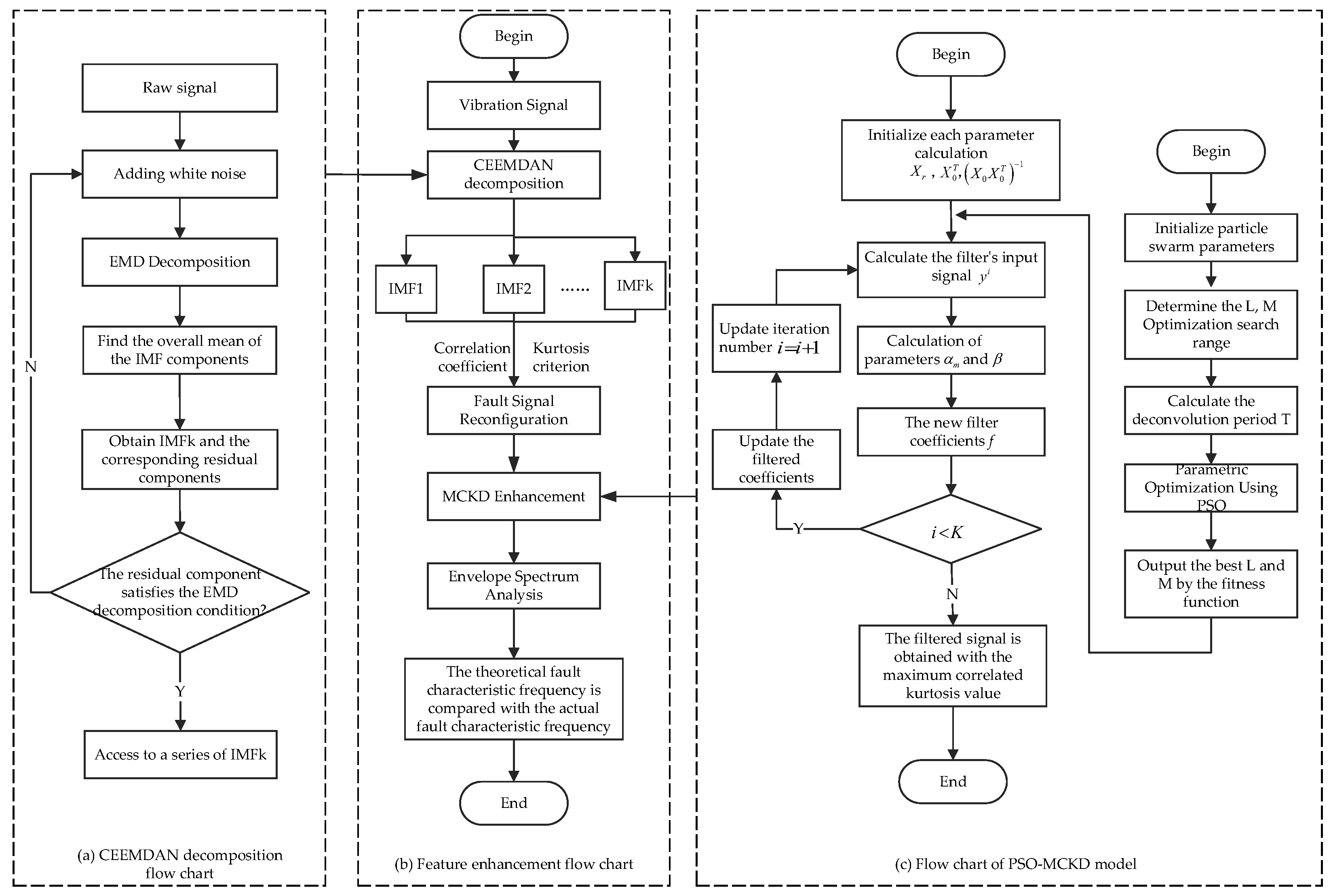
- 4.
- Deconvolution of the reconstructed signal by bringing the optimal parameters L, M, and T into the MCKD algorithm to weaken the effect of noise on the signal and enhance the impact characteristics.
- 5.
- To achieve the feature extraction of the bearing, envelope processing is implemented on the enhanced signal.
4. Simulation Signal Analysis
5. Test Verification
5.1. Equipment and Data
- XJTU-SY Bearing Data
- B.
- Bearing Data Collected in the Laboratory
5.2. Experimental Study under Constant Operating Conditions
5.3. Experimental Study under Variable Working Conditions
6. Conclusions
- (1)
- The fault signal is decomposed using the CEEMDAN algorithm to obtain a set of IMF components, and the sensitive IMF components are selected according to the kurtosis-correlation coefficient criterion and the signal is reconstructed, which can effectively remove the noise from the fault signal.
- (2)
- In comparison to the MED method, the MCKD algorithm may emphasize continuous shock pulses in rotating equipment. PSO-MCKD then processes the signal to efficiently improve the signal’s weak shock components after noise reduction.
- (3)
- Envelope analysis is performed on the signal processed by feature enhancement to realize the extraction of bearing incipient fault features. The bearing inner ring faults under constant working conditions and the bearing outer ring faults under varied working conditions are used to demonstrate the method’s usefulness. When compared to the PSO-MCKD and CEEMDAN-MED approaches, it exhibits better feasibility and generality.
Author Contributions
Funding
Institutional Review Board Statement
Informed Consent Statement
Data Availability Statement
Acknowledgments
Conflicts of Interest
References
- Zhang, X.H.; Kang, J.S.; Kang, J.S.; Hao, L.S.; Cai, L.Y.; Zhao, J.M. Bearing fault diagnosis and degradation analysis based on improved empirical mode decomposition and maximum correlated kurtosis deconvolution. J. Vibroeng. 2015, 171, 243–260. [Google Scholar]
- Lv, Z.L.; Tang, B.P.; Zhou, Y.; Meng, J. Early fault diagnosis method for rolling bearings based on grid search method with optimized maximum correlation kurtosis cliff deconvolution. Vib. Shock. 2016, 35, 29–34. [Google Scholar]
- Qin, C.; Wang, D.; Xu, Z.; Tang, G. Improved Empirical Wavelet Transform for Compound Weak Bearing Fault Diagnosis with Acoustic Signals. Appl. Sci. 2020, 10, 682. [Google Scholar] [CrossRef]
- Yuan, J.; Xu, C.; Zhao, Q.; Jiang, H.M.; Weng, Y.H. High-fidelity noise-reconstructed empirical mode decomposition for mechanical multiple and weak fault extractions. ISA Trans. 2022, 129, 380–397. [Google Scholar] [CrossRef]
- Shen, K.; Zhao, D.B. An EMD-LSTM Deep Learning Method for Aircraft Hydraulic System Fault Diagnosis under Different Environmental Noises. Aerospace 2023, 10, 55. [Google Scholar] [CrossRef]
- Damine, Y.; Bessous, N.; Pusca, R.; Megherbi, A.C.; Romary, R.; Sbaa, S. A New Bearing Fault Detection Strategy Based on Combined Modes Ensemble Empirical Mode Decomposition, KMAD, and an Enhanced Deconvolution Process. Energies 2023, 16, 2604. [Google Scholar] [CrossRef]
- Zheng, K.; Luo, J.F.; Zhang, Y.; Li, T.L.; Wen, J.F.; Xiao, H. Incipient fault detection of rolling bearing using maximum autocorrelation impulse harmonic to noise deconvolution and parameter optimized fast EEMD. ISA Trans. 2019, 89, 256–271. [Google Scholar] [CrossRef] [PubMed]
- Lin, S.L. Application combining VMD and ResNet101 in intelligent diagnosis of motor faults. Sensors 2021, 21, 6065. [Google Scholar] [CrossRef] [PubMed]
- Torres, M.E.; Colominas, M.A.; Schlotthauer, G.; Flandrin, P. A complete ensemble empirical mode decomposition with adaptive noise. In Proceedings of the 2011 IEEE International Conference on Acoustics, Speech and Signal Processing (ICASSP), Prague, Czech Republic, 22–27 May 2011. [Google Scholar]
- Bie, F.F.; Miao, Y.; Lyu, F.; Peng, J.; Guo, Y. An improved CEEMDAN time-domain energy entropy method for the failure mode identification of the rolling bearing. Shock. Vib. 2021, 2021, 7461402. [Google Scholar] [CrossRef]
- Liu, L.P.; Wei, Y.; Song, X.Y.; Zhang, L. Fault Diagnosis of Wind Turbine Bearings Based on CEEMDAN-GWO-KELM. Energies 2023, 16, 48. [Google Scholar] [CrossRef]
- Zhang, H.; Chen, X.; Du, Z.H.; Yan, R.Q. Kurtosis based weighted sparse model with convex optimization technique for bearing fault diagnosis. Mech. Syst. Signal Process. 2016, 80, 349–376. [Google Scholar] [CrossRef]
- Wiggins, R.A. Minimum entropy deconvolution. Geoexploration 1978, 16, 21–35. [Google Scholar] [CrossRef]
- Li, H.K.; Zhao, C.S.; Zhou, S.; Guo, Y.J. Fault feature enhancement method of rolling bearing based on wavelet packet—Coordinate transformation. J. Mech. Eng. 2011, 47, 74–80. [Google Scholar] [CrossRef]
- Qiao, Z.C.; Liu, Y.Q.; Liao, Y.Y. Application of improved empirical wavelet transform with minimum entropy deconvolution in railroad bearing fault diagnosis. Vib. Shock. 2021, 40, 81–90. [Google Scholar]
- Ha, J.M.; Youn, B.D. Fault diagnosis of a planetary gearbox by D norm-based time synchronous averaging (DTSA) with roughly estimated phase information under an encoder-less operating condition. J. Sound Vib. 2022, 520, 116546. [Google Scholar] [CrossRef]
- Endo, H.; Randall, R.B. Enhancement of autoregressive model based gear tooth fault detection technique by the use of minimum entropy deconvolution filter. Mech. Syst. Signal Process. 2007, 21, 906–919. [Google Scholar] [CrossRef]
- Ou, L.; Yu, D.; Yang, H. A new rolling bearing fault diagnosis method based on GFT impulse component extraction. Mech. Syst. Signal Process. 2016, 81, 162–182. [Google Scholar] [CrossRef]
- Mcdonald, G.L.; Zhao, Q. Maximum correlated kurtosis deconvolution and application on gear tooth chip fault detection. Mech. Syst. Signal Process. 2012, 33, 237–255. [Google Scholar] [CrossRef]
- Cui, H.; Guan, Y.; Chen, H. Rolling element fault diagnosis based on VMD and sensitivity MCKD. IEEE Access 2021, 9, 120297–120308. [Google Scholar] [CrossRef]
- Zhang, J.; Zhang, J.Q.; Zhong, M.; Zheng, J.D.; Li, X.K. Faint fault diagnosis of wind turbine bearings based on PSO-VMD-MCKD method. Vib. Test Diagn. 2020, 40, 287–296. [Google Scholar]
- Zhang, L.; Xiong, G.L.; Huang, W.Y. Complex wavelet resonance demodulation band optimization method and new metrics. J. Mech. Eng. 2015, 51, 129–138. [Google Scholar] [CrossRef]
- Xiao, J.Q.; Jin, J.T.; Li, C.; Xu, Z.F. Research on rolling bearing fault diagnosis based on IVMD-MCKD. Therm. Power Eng. 2022, 37, 165–173. [Google Scholar]
- Lei, Y.G.; Han, T.Y.; Wang, B.; Li, N.P.; Run, T.; Yang, J. Interpretation of XJTU-SY rolling bearing accelerated life test data set. J. Mech. Eng. 2019, 55, 1–6. [Google Scholar]
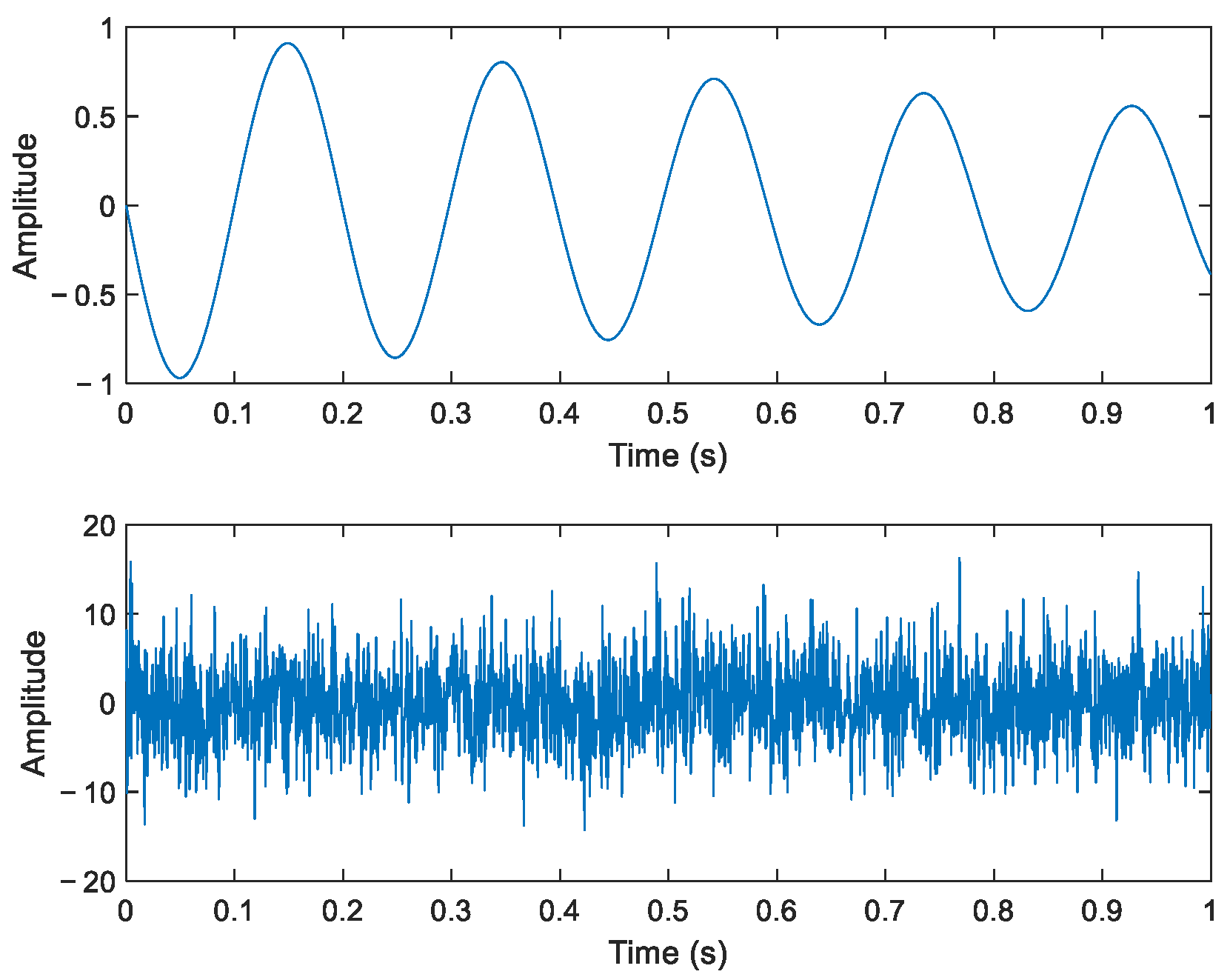


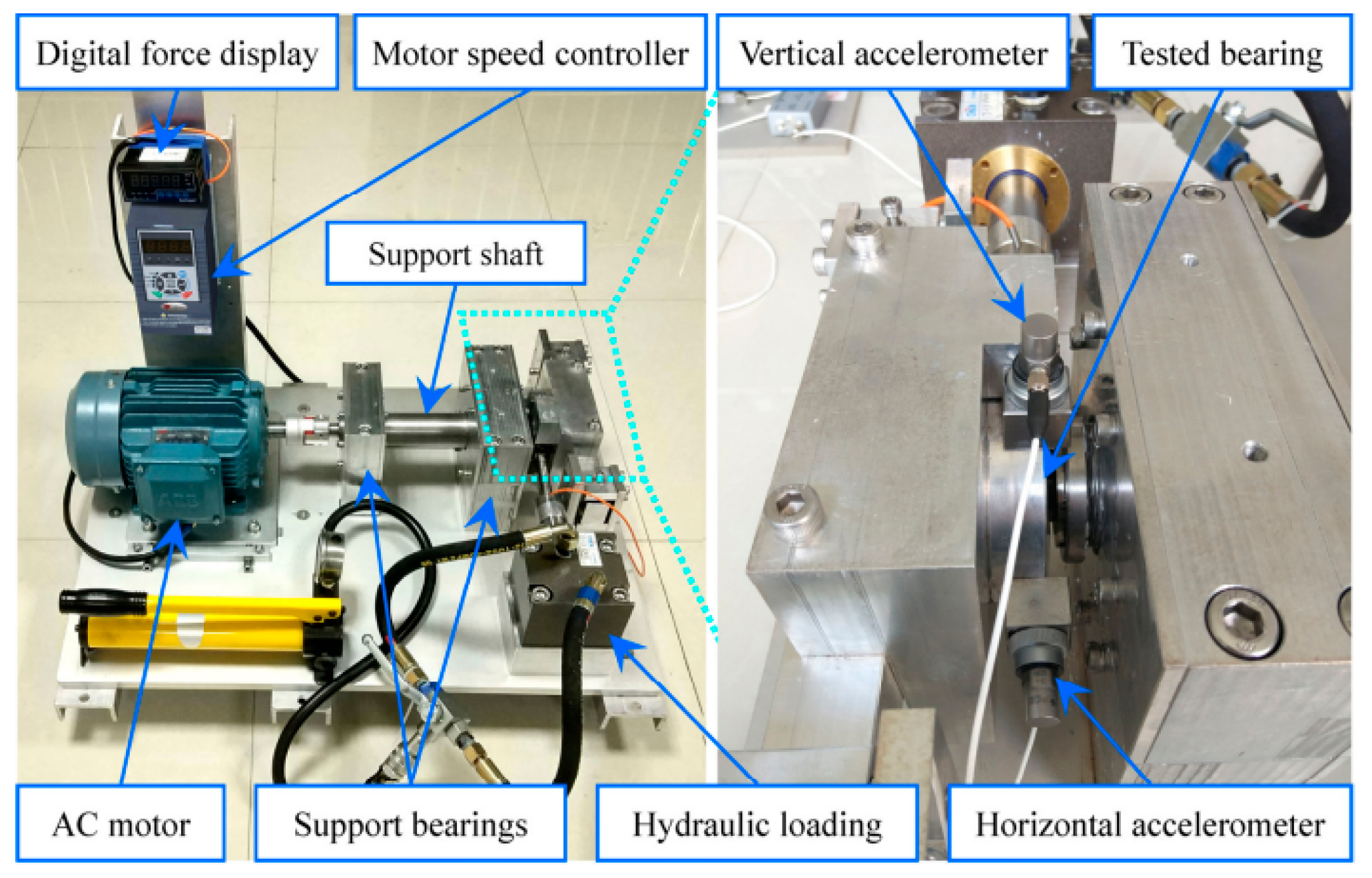
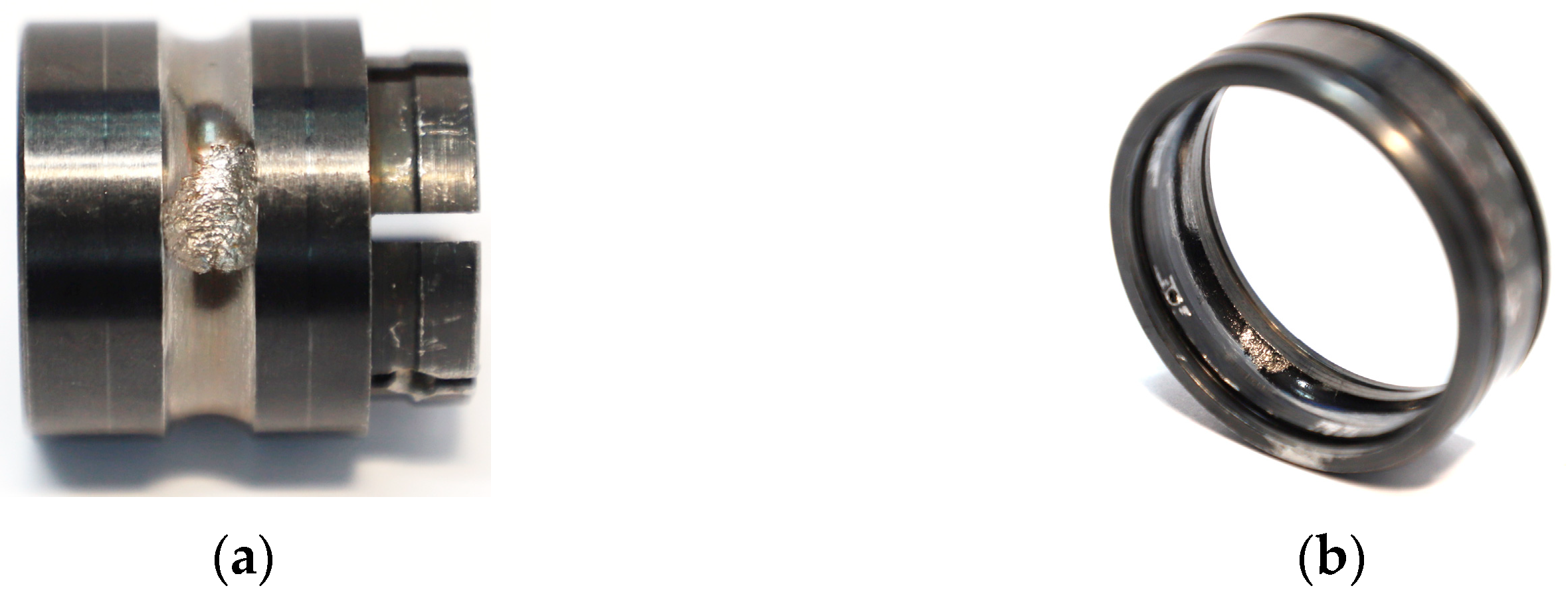




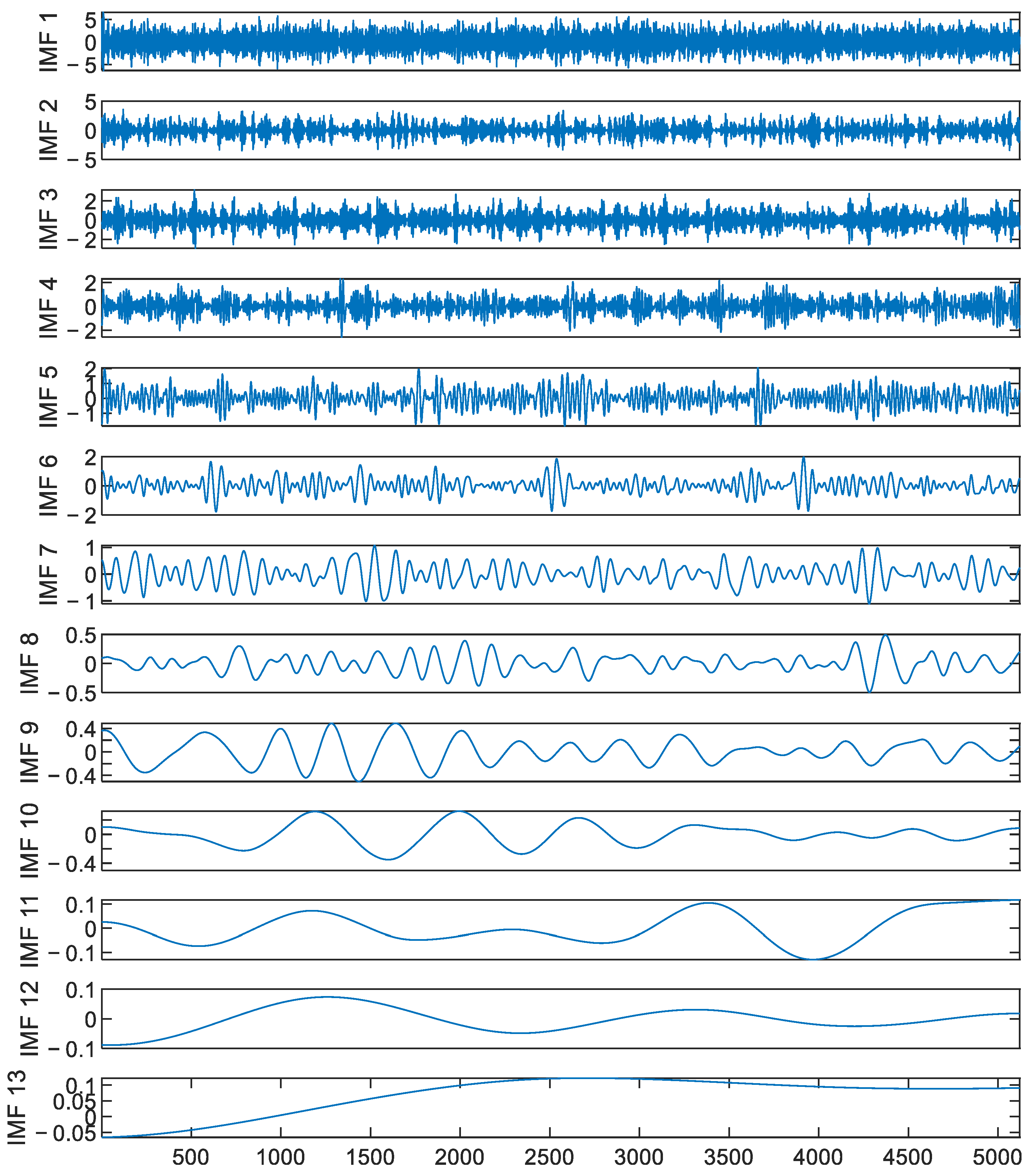

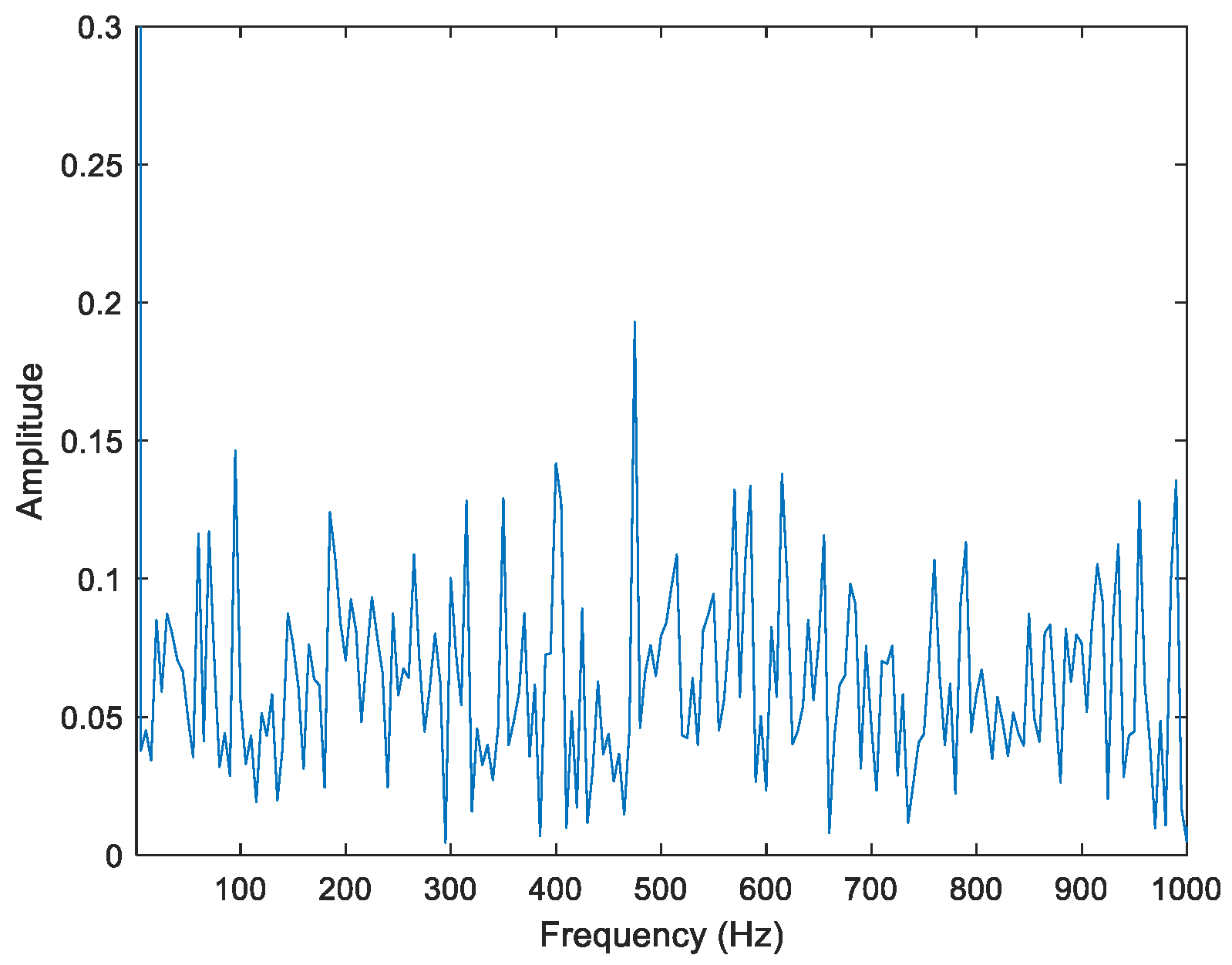

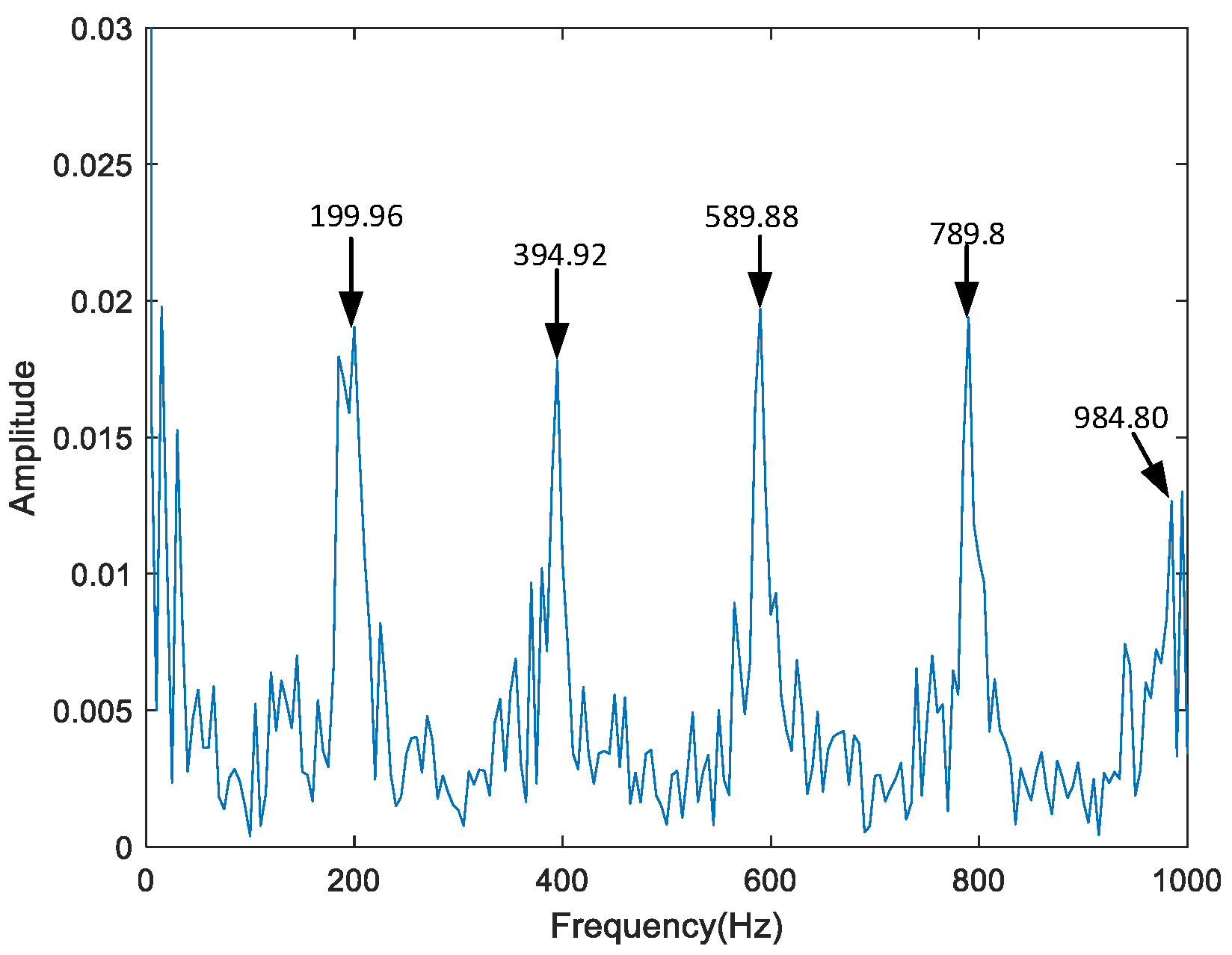
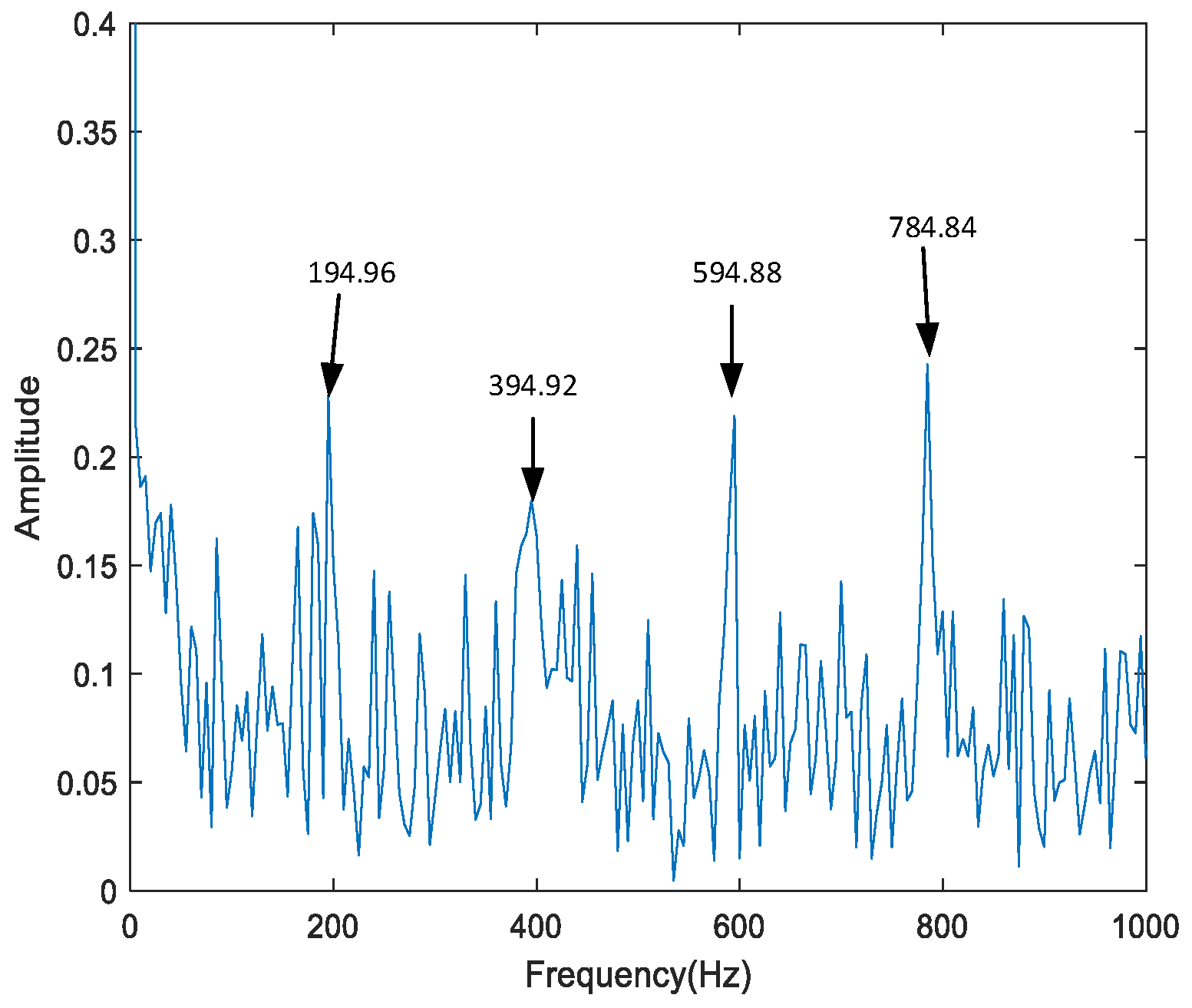
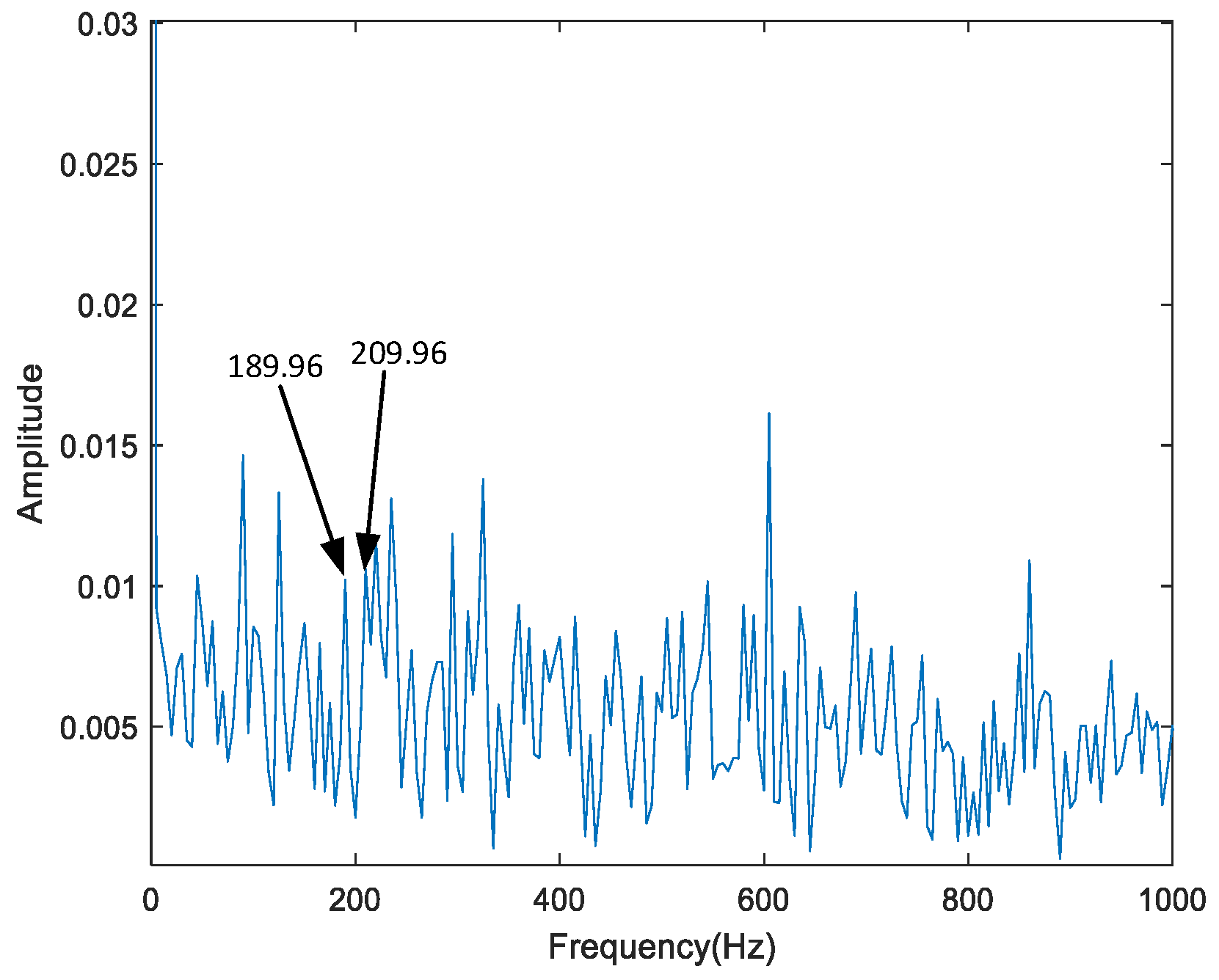
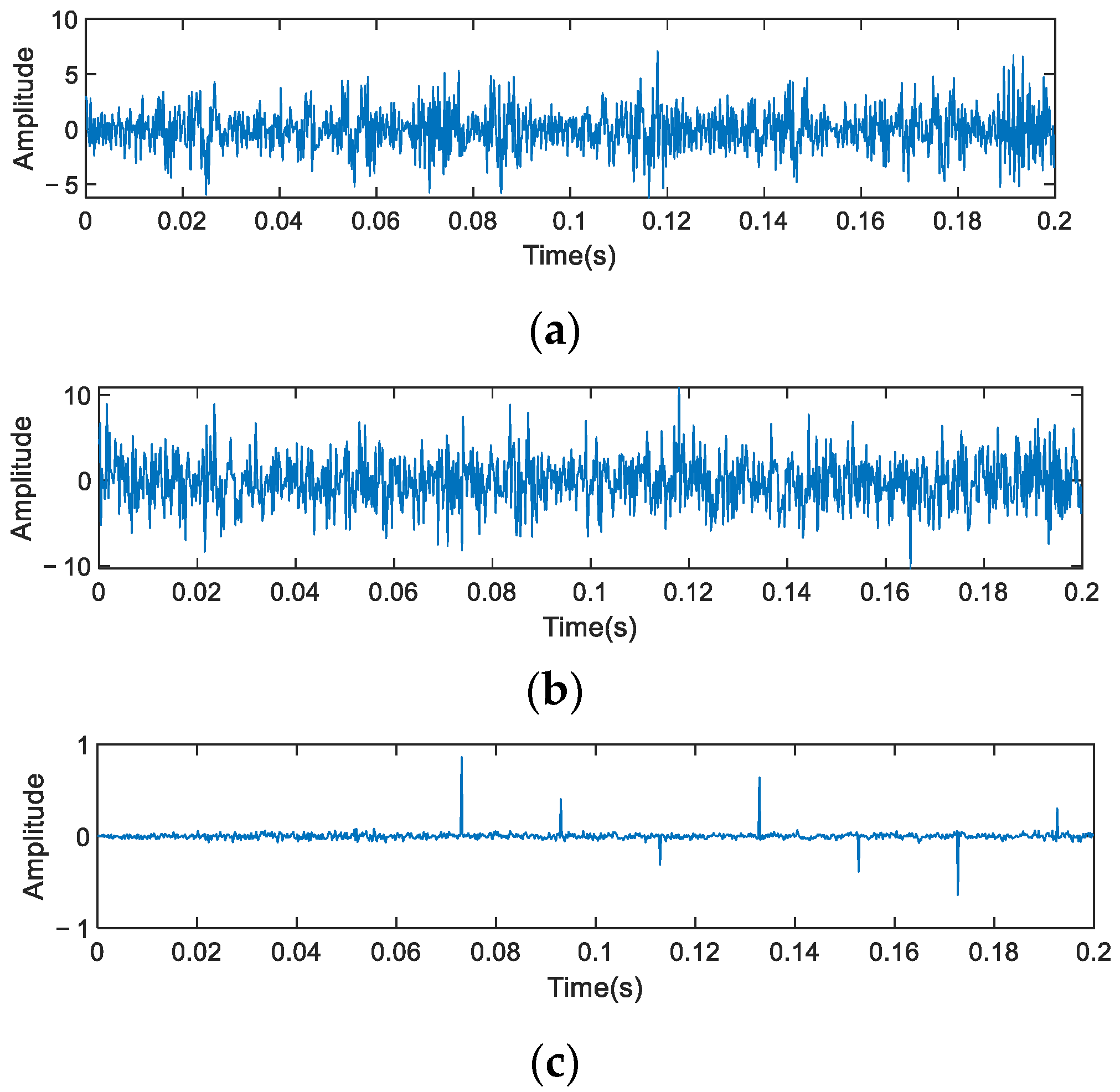
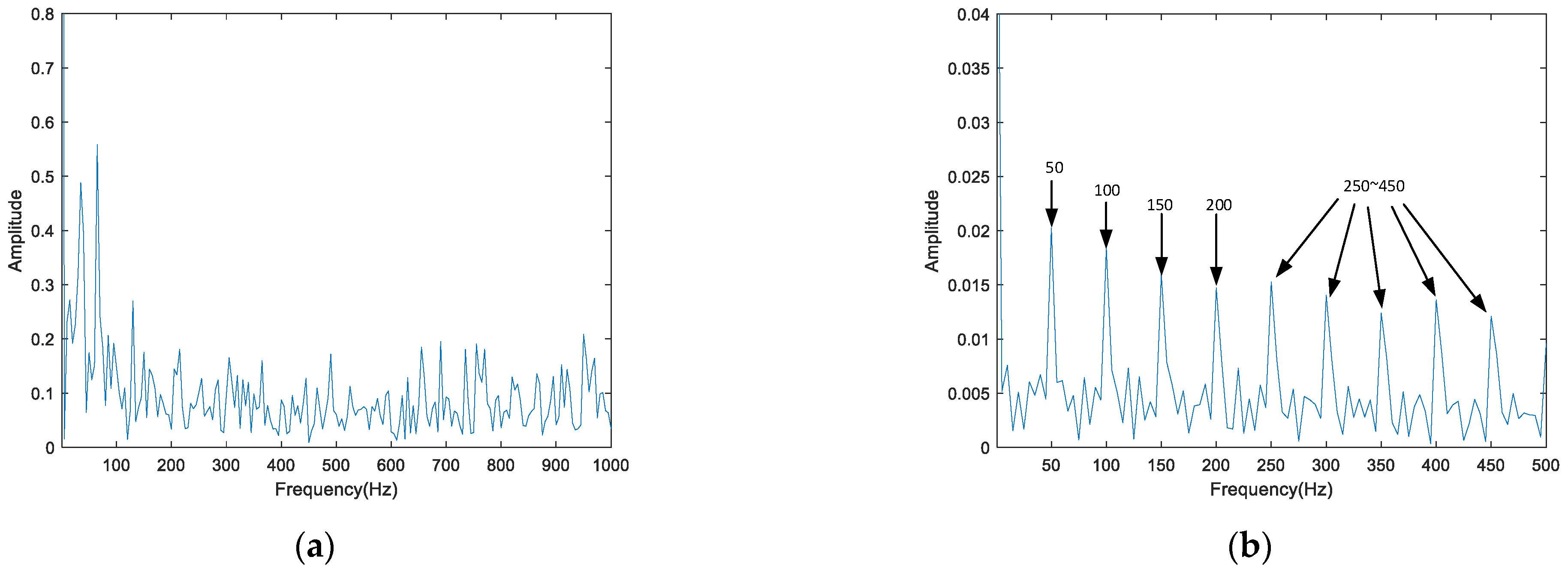


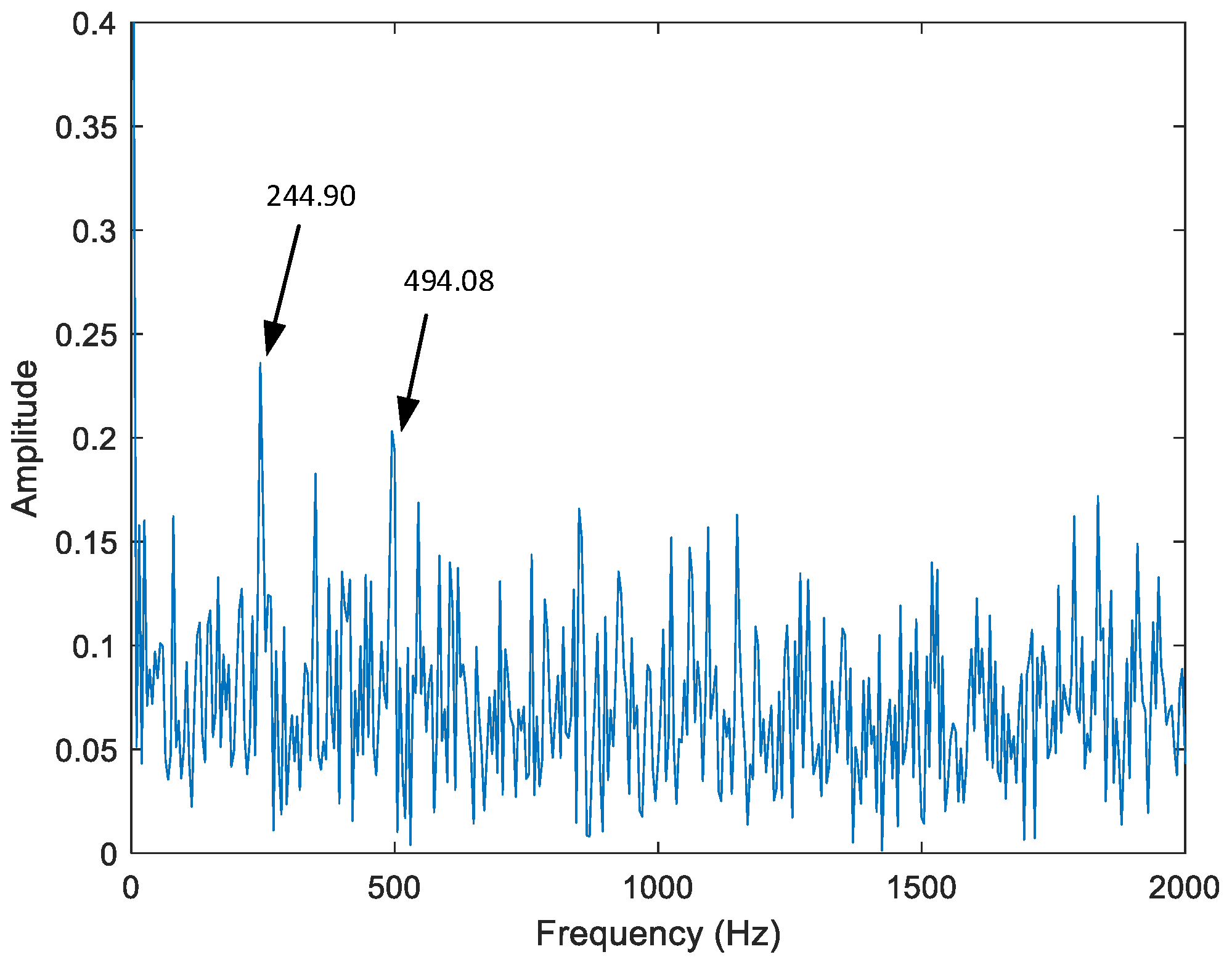



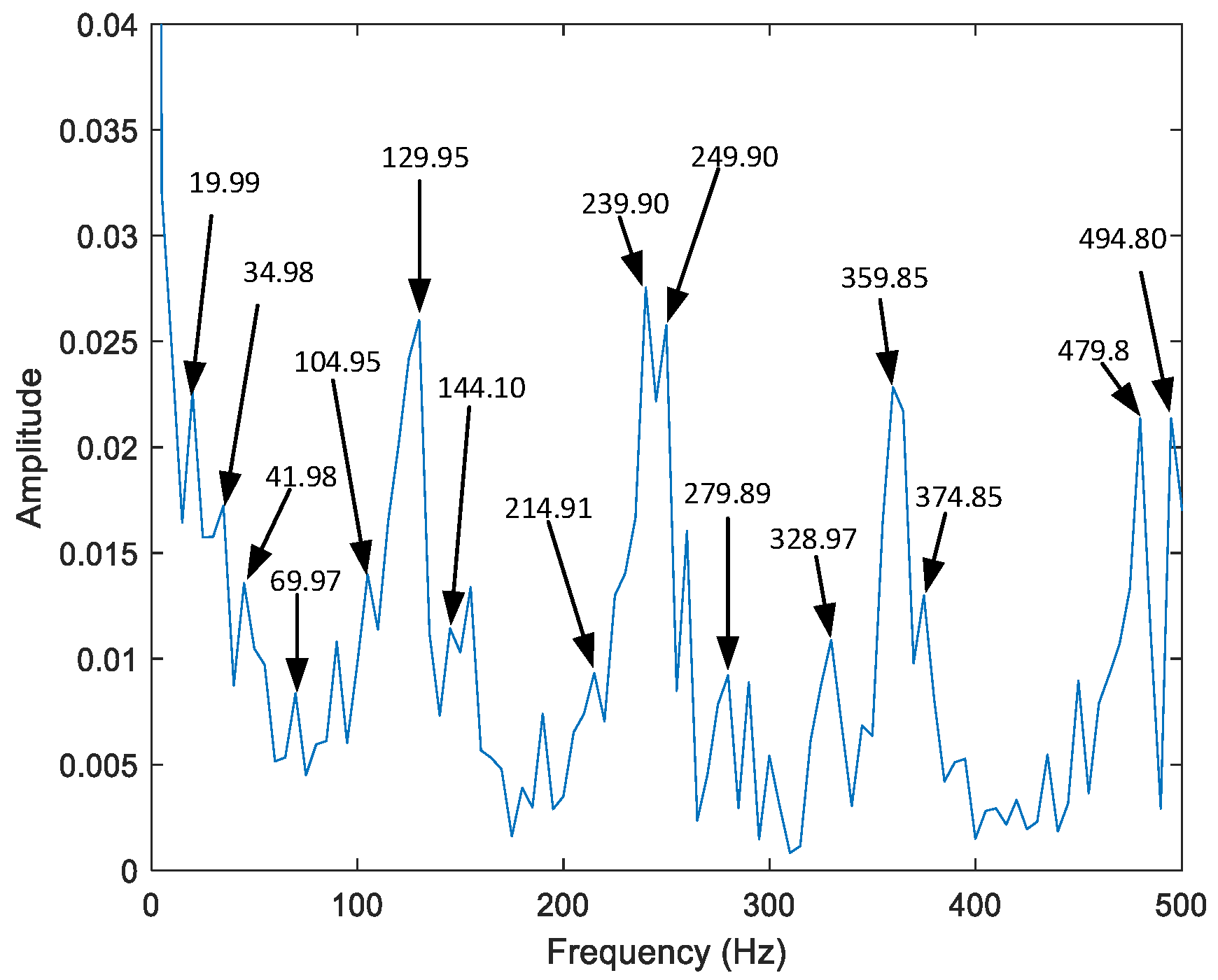
| Bearing Mean Diameter | Ball Diameter | Number of Balls | Contact Angle |
|---|---|---|---|
| 34.55 mm | 7.92 mm | 8 | 0° |
| IMF Component | Kurtosis | Correlation Coefficient |
|---|---|---|
| IMF1 | 2.0957 | 0.7370 |
| IMF2 | 3.6166 | 0.4661 |
| IMF3 | 3.4088 | 0.4249 |
| IMF4 | 3.1486 | 0.3420 |
| IMF5 | 3.2082 | 0.2770 |
| IMF6 | 4.5772 | 0.2068 |
| IMF7 | 2.7392 | 0.1573 |
| IMF8 | 3.4486 | 0.0816 |
| IMF9 | 2.5464 | 0.0719 |
| IMF10 | 2.8642 | 0.0612 |
| IMF11 | 2.1216 | 0.0261 |
| IMF12 | 2.6415 | 0.0253 |
| IMF13 | 2.8042 | 0.0274 |
| IMF Component | IMF1 | IMF2 | IMF3 | IMF4 | IMF5 | IMF6 | IMF7 | IMF8 |
|---|---|---|---|---|---|---|---|---|
| Kurtosis | 2.028 | 3.965 | 3.297 | 4.681 | 3.183 | 3.525 | 3.314 | 3.004 |
| Correlation coefficient | 0.710 | 0.445 | 0.415 | 0.407 | 0.371 | 0.222 | 0.147 | 0.085 |
Disclaimer/Publisher’s Note: The statements, opinions and data contained in all publications are solely those of the individual author(s) and contributor(s) and not of MDPI and/or the editor(s). MDPI and/or the editor(s) disclaim responsibility for any injury to people or property resulting from any ideas, methods, instructions or products referred to in the content. |
© 2023 by the authors. Licensee MDPI, Basel, Switzerland. This article is an open access article distributed under the terms and conditions of the Creative Commons Attribution (CC BY) license (https://creativecommons.org/licenses/by/4.0/).
Share and Cite
Zhao, L.; Chi, X.; Li, P.; Ding, J. Incipient Fault Feature Enhancement of Rolling Bearings Based on CEEMDAN and MCKD. Appl. Sci. 2023, 13, 5688. https://doi.org/10.3390/app13095688
Zhao L, Chi X, Li P, Ding J. Incipient Fault Feature Enhancement of Rolling Bearings Based on CEEMDAN and MCKD. Applied Sciences. 2023; 13(9):5688. https://doi.org/10.3390/app13095688
Chicago/Turabian StyleZhao, Ling, Xin Chi, Pan Li, and Jiawei Ding. 2023. "Incipient Fault Feature Enhancement of Rolling Bearings Based on CEEMDAN and MCKD" Applied Sciences 13, no. 9: 5688. https://doi.org/10.3390/app13095688





